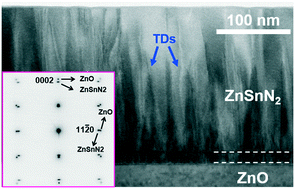High electron mobility single-crystalline ZnSnN2 on ZnO (0001) substrates
Abstract
Making a systematic effort, we have developed single-crystalline ZnSnN2 on ZnO (0001) by reactive magnetron co-sputtering. Epitaxial growth was achieved at 350 °C by co-sputtering from metal targets in a nitrogen atmosphere, and confirmed by transmission electron microscopy (TEM) measurements. TEM verified that the layers are single-crystalline of hexagonal phase, exhibiting an epitaxial relationship with the substrate described by: [11−20]ZnSnN2//[11−20]ZnO and [0001]ZnSnN2//[0001]ZnO. The screw-type threading dislocations originating from the ZnSnN2/ZnO interface were identified as the dominant extended defects. More specifically, we report a pioneering measurement of the dislocation density in this material of 1.5 × 1011 cm−2. Even though there are no literature data for direct comparison, such values are typical of heteroepitaxial growth of III-nitride layers without applying defect density reduction strategies. The films demonstrated a high electron mobility of 39 cm2 V−1 s−1 and 63 cm2 V−1 s−1 for stoichiometric and Zn-rich layers, respectively, while the electron carrier density remained in the low 1019 cm−3 range as determined by the Hall effect measurements at room temperature. Optical bandgaps of 1.86 eV and 1.72 eV were determined for the stoichiometric and Zn-rich samples, respectively. As such, we conclude that ZnSnN2 is an earth-abundant, environmentally-friendly semiconductor and is a promising candidate for cost efficient components in optoelectronics and photovoltaics.



 Please wait while we load your content...
Please wait while we load your content...